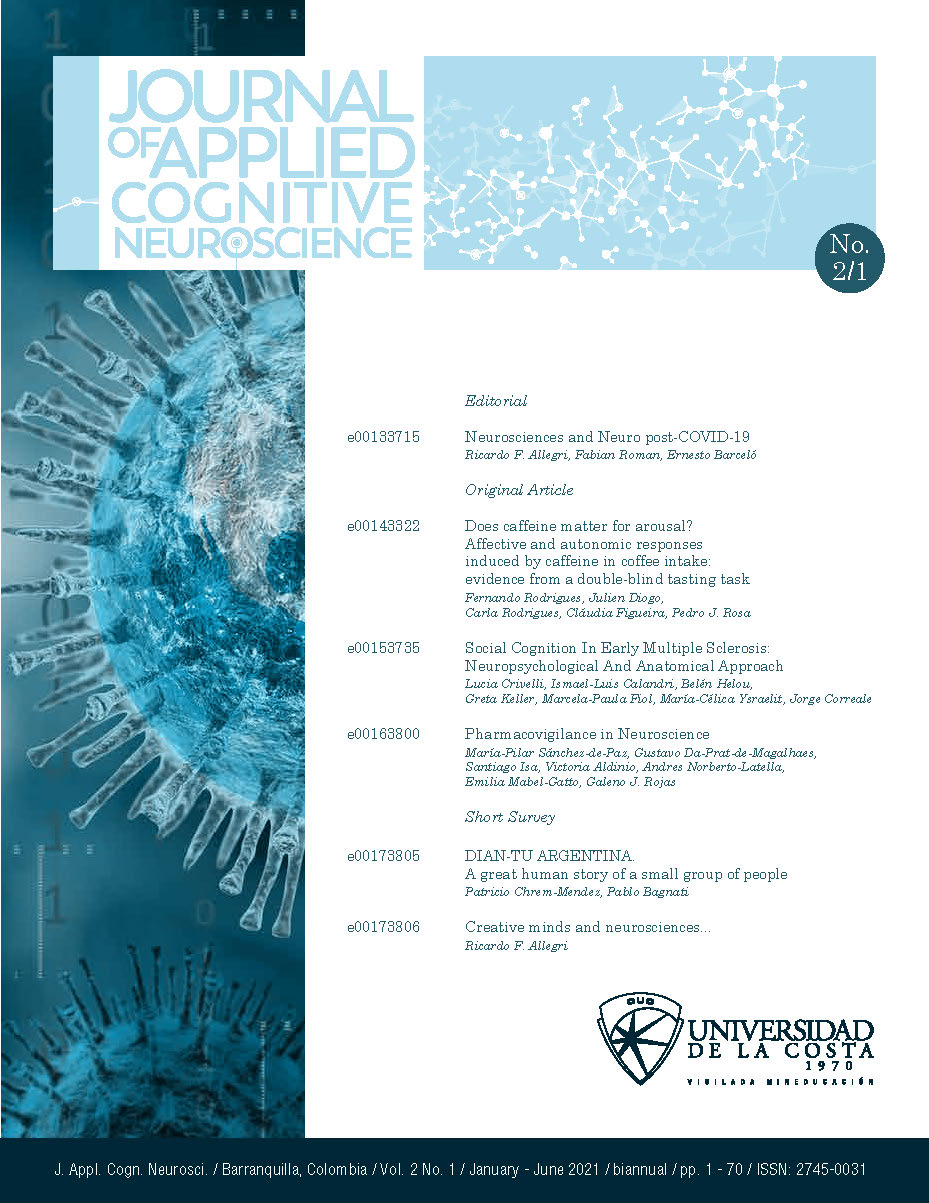Social Cognition In Early Multiple Sclerosis: Neuropsychological And Anatomical Approach
Cognición Social En La Esclerosis Múltiple Temprana: Enfoque Neuropsicológico Y Anatómico
DOI:
https://doi.org/10.17981/JACN.2.1.2021.03Keywords:
Cognitive Dysfunction, Social Cognition, Multiple Sclerosis, Neuropsychological Test, Disease ProgressionAbstract
Cognitive impairment and deficits in social cognition (SC) are frequent in patients with multiple sclerosis (MS). The aim of the present work is to study SC in patients with early MS and to analyze its neuroanatomical correlation. Thirty-four patients with relapsing remitting MS, with ≤ 2 years of disease progression and EDSS and ≤2, and 30 healthy control subjects matched for age, sex, and educational level were recruited. Subjects performed a comprehensive neuropsychological assessment (Rao BRB). SC was assessed using the International Affective Picture System IAPS, The Eyes in the Mind Test, the Empathy Quotient, and the Faux Pas Test. The anatomical correlation of patients with deficits in social cognition was studied through brain MRI and voxel-based morphometric for which cortical reconstruction and volumetric segmentation were performed using Freesurfer processing software. Patients showed significant deficits in executive functions, verbal memory and language tests. SC assessment showed that patients presented greater difficulties in the Faux Pas Test (p = 0.023), The Mind in the Eyes Test (p = 0.014), and presented a positive bias in the interpretation of neutral images of the IAPS (P = 0.023). Furthermore, patients with CS deficits presented less cortical thickness in areas of the right supramarginal gyrus, pars opercularis, and anterior cingulum.
Downloads
References
Apps, M. A.; Rushworth, M. F. & Chang, S. W. (2016). The Anterior Cingulate Gyrus and Social Cognition: Tracking the Motivation of Others. Neuron, 90(4), 692–707.
https://doi.org/10.1016/j.neuron.2016.04.018
Banati, M.; Sandor, J.; Mike A.; Illes, E.; Bors, L.; Feldmann, A.; Herold, R. & Illes, Z. (2010). Social cognition and Theory of Mind in patients with relapsing-remitting multiple sclerosis. Europena Journal of Neurology, 17(3), 426–433.
https://doi.org/10.1111/j.1468-1331.2009.02836.x
Baron-Cohen, S. & Wheelwright, S. (2004). The Empathy Quotient: An Investigation Of Adults With Asperger Syndrome Or High Functioning Autism, And NormalSex Differences, Journal of Autism and Developmental Disorders, 34(2), 163–175.
https://doi.org/10.1023/b:jadd.0000022607.19833.00
Batista, S.; D’Almeida, O. C.; Afonso, A.; Freitas, S.; Macário, C.; Sousa, L.; Castelo-Branco, M.; Santana, I. & Cunha, L. (2017). Impairment of social cognition in multiple sclerosis: Amygdala atrophy is the main predictor. Multiple Sclerosis Journal, 23(10), 1358–1366.
https://doi.org/10.1177/1352458516680750
Bradley, M. & Lang, P. (1994). Measuring emotion: The self-assessment manikin and the semantic differential. Journal of Behavior Therapy and Experimental Psychiatry, 25(1), 49–59.
https://doi.org/10.1016/0005-7916(94)90063-9
Cáceres, F.; Vanotti, S.; Rao, S. & RECONEM Workgroup. (2011). Epidemiological characteristics of cognitive impairment of multiple sclerosis patients in a Latin American country. Journal of Clinical and Experimental Neuropsychology, 33(10), 1094–1098.
https://doi.org/10.1080/13803395.2011.603690
Calder, A. J.; Keane, J.; Lawrence, A. D. & Manes F. (2004). Impaired recognition of anger following damage to the ventral striatum. Brain: a journal of Neulogy, 127(Pt 9), 1958–1969.
https://doi.org/10.1093/brain/awh214
Chiaravalloti, N. D. & DeLuca, J. (2008). Cognitive impairment in multiple sclerosis. The Lancet Neurol, 7(12), 1139–1151.
https://doi.org/10.1016/s1474-4422(08)70259-x
Cotter J.; Firth, J.; Enzinger, C.; Kontopantelis, E.; Yung, A. R.; Elliott, R. & Drake, R. J. (2016). Social cognition in multiple sclerosis: A systematic review and meta-analysis. Neurology, 87(16), 1727–1736.
https://doi.org/10.1212/wnl.0000000000003236
Di Bitonto, L.; Longato, N.; Jung, B.; Fleury, M.; Marcel, C.; Collongues, N.; de Seze, J. & Blanc, F. (2011). Reduced emotional reactivity to negative stimuli in multiple sclerosis, preliminary results. Revue Neurolique (Paris), 167(11), 820–826.
https://doi.org/10.1016/j.neurol.2011.01.024
Henry, J. D.; Phillips, L. H.; Beatty, W. W.; McDonald, S.; Longley, W. A.; Joscelyne, A. & Rendell, P. G. (2009). Evidence for deficits in facial affect recognition and theory of mind in multiple sclerosis. Journal of the International Neuropsychological Society, 15(2), 277–285.
https://doi.org/10.1017/s1355617709090195
Jehna, M.; Langkammer, C.; Wallner-Blazek, M.; Neuper, Ch.; Loitfelder, M.; Ropele, S.; Fuchs, S.; Khalil, M.; Pluta-Fuerst, A.; Fazekas, F. & Enzinger, Ch. (2011). Cognitively preserved MS patients demonstrate functional differences in processing neutral and emotional faces. Brain Imaging and Behavior, 5(4), 241–251.
https://doi.org/10.1007/s11682-011-9128-1
Kurtzke J. F. (1983). Rating neurologic impairment in multiple sclerosis: an expanded disability status scale (EDSS). Neurology, 33(11), 1444–1452.
https://doi.org/10.1212/wnl.33.11.1444
Lang, P. J.; Bradley, M. M. & Cuthbert, B. N. (2008). International affective picture system (IAPS): Affective ratings of pictures and instruction manual. [Technical Report A-8]. Gainesville: University of Florida. Available from
https://www2.unifesp.br/dpsicobio/adap/instructions.pdf
Langdon, D. W. (2011). Cognition in Multiple Sclerosis. Current Opinion in Neurology, 24(3), 244–249.
https://doi.org/10.1097/wco.0b013e328346a43b
Louwerse, A.; Tulen, J. H.; van der Geest, J. N.; van der Ende, J. & Verhulst, F. C. (2014). Greaves-Lord K. Autonomic responses to social and nonsocial pictures in adolescents with autism spectrum disorder. Autism Research, 7(1), 17–27.
https://doi.org/10.1002/aur.1327
Mao, C. V.; Araujo, M. F.; Nishimaru, H.; Matsumoto, J.; Tran, A. H.; Hori, E.; Ono, T. & Nishijo, H. (2017). Pregenual Anterior Cingulate Gyrus Involvement in Spontaneous Social Interactions in Primates-Evidence from Behavioral, Pharmacological, Neuropsychiatric, and Neurophysiological Findings. Frontiers in Neuroscience, 11, 1–10.
https://dx.doi.org/10.3389%2Ffnins.2017.00034
McDonald, W. I.; Compston, A.; Edan, G.; Goodkin, D.; Hartung, H. P.; Lublin, F. D.; McFarland, H. F.; Paty, D. W.; Polman, C. H.; Reingold, S. C.; Sandberg-Wollheim, M.; Sibley, W.; Thompson, A.; Van den Noort, S.; Weinshenker, B. Y.; Wolinsky, J. S. (2001). Recommended diagnostic criteria for multiple sclerosis: guidelines from the International Panel on the diagnosis of multiple sclerosis. Annals of Neurology, 50(1), 121–127.
https://doi.org/10.1002/ana.1032
Ouellet, J.; Scherzer, P. B.; Rouleau, I.; Métras, P.; Bertrand-Gauvin, C.; Djerroud, N.; Boisseau E. & Duquette, P. (2010). Assessment of social cognition in patients with multiple sclerosis. Journal of the IntNeuropsychological Society, 16(2), 287–296.
https://doi.org/10.1017/s1355617709991329
Román, F.; Rojas, Galeno; N. R., Iturry, M.; Blanco, R.; Leis, A.; Bartoloni, L. & Allegri , R. F. (2012). Baremos del Test de la Mirada en español en adultos normales de Buenos Aires. Revista Neuropsicología Latinoamericana, 4(3), 1–5. Disponible en
https://www.neuropsicolatina.org/index.php/Neuropsicologia_Latinoamericana/article/view/108
Schulz, K. P.; Clerkin, S. M.; Halperin, J. M.; Newcorn, J. H.; Tang, C. Y. & Fan, J. (2009). Dissociable neural effects of stimulus valence and preceding context during the inhibition of responses to emotional faces. Hum Brain Mapp, 30(9), 2821–2833.
https://doi.org/10.1002/hbm.20706
Sprengelmeyer, R.; Young, A. W., Calder, A. J., Karnat, A.; Lange, H.; Hömberg, V.; Perrett, D. I. & Rowland, D. (1996). Loss of disgust. Perception of faces and emotions in Huntington’s disease. Brain: a journal of Neulogy, 119( Pt 5), 1647–1665.
https://doi.org/10.1093/brain/119.5.1647
Stone, V. E.; Baron-Cohen, S. & Knight, R. T. (1998). Frontal lobe contributions to theory of mind. Journal of Cognitive Neuroscience, 10(5), 640–656.
Published
How to Cite
Issue
Section
License
Copyright (c) 2021 Journal of Applied Cognitive Neuroscience

This work is licensed under a Creative Commons Attribution-NonCommercial-NoDerivatives 4.0 International License.
You are free to:
- Share — copy and redistribute the material in any medium or format.
- The licensor cannot revoke these freedoms as long as you follow the license terms.
Under the following terms:
- Attribution — You must give appropriate credit, provide a link to the license, and indicate if changes were made. You may do so in any reasonable manner, but not in any way that suggests the licensor endorses you or your use.
- NonCommercial — You may not use the material for commercial purposes.
- NoDerivatives — If you remix, transform, or build upon the material, you may not distribute the modified material.
- No additional restrictions — You may not apply legal terms or technological measures that legally restrict others from doing anything the license permits.


 English
English
 Español (España)
Español (España)










